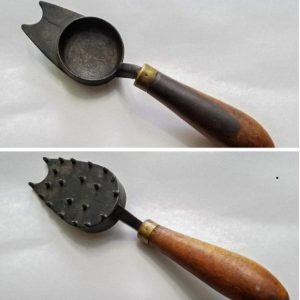The Jew’s harp, also known as the mouth harp, jaw harp, or juice harp, is an ancient and fascinating musical instrument with a unique sound and a deep cultural history. While its name may suggest a connection to Jewish culture, this instrument has no historical ties to the Jewish people. Instead, its roots lie in the Altai Mountains of Siberia, within Turkic cultures. Over the centuries, the Jew’s harp has gained worldwide recognition, cherished for its distinct sound and diverse playing techniques. In this article, we will explore the origins, mechanics, cultural significance, and modern-day relevance of the Jew’s harp.
What Is a Jew’s Harp? Understanding the Basics

The Jew’s harp is a small, handheld musical instrument that produces sound through the vibration of a flexible reed or tongue. The instrument is typically made from metal, bamboo, or bone, and it features a frame that holds the reed in place. When plucked or struck, the reed vibrates, and the sound is amplified by the performer’s mouth or teeth, which act as a resonator.
The musician holds the instrument against their lips or teeth, plucking the reed with their finger or tapping it gently. The sound produced can be varied by altering the shape of the mouth, tongue, and throat. This allows the player to create distinct pitches, overtones, and melodies. Though the design and playing technique may differ slightly by culture, the basic principle of the Jew’s harp remains the same: to create sound by vibrating a reed with the help of the mouth and breath.
The Fascinating History and Origins of the Jew’s Harp
The precise origin of the Jew’s harp is still debated, but it is believed to have first appeared in the Altai Mountains, located in Siberia, thousands of years ago. This region, known for its Turkic culture, holds the key to the Jew’s harp’s early history. Archaeological evidence suggests that the instrument dates back at least 2,500 years, with artifacts found in both Europe and Asia. One of the most notable discoveries occurred in 2018 when an ancient bone-made mouth harp was unearthed in the Altai Mountains, estimated to be around 1,700 years old.
Despite its name, the Jew’s harp is not linked to Jewish culture. The term “Jew’s harp” likely stems from a linguistic evolution, with some theorists suggesting it originated from the Old English word “gewgaw” (a trinket or novelty) or a distortion of the word “jaw.” Regardless of its name, the Jew’s harp became widely known in European cultures and has had various names across the world, including “mukhale” in Mongolia and “komus” in Russia.
How Does a Jew’s Harp Work? The Mechanics Behind the Sound
The Jew’s harp operates as an idiophone, a category of musical instruments that generate sound by vibrating without the use of strings or membranes. When the reed is plucked or struck, it vibrates between the arms of the frame. These vibrations create sound waves that travel through the resonating chamber formed by the performer’s mouth, enhancing the tone.
Jew’s harps are traditionally crafted from metals such as copper, steel, or brass, although some cultures use bamboo, bone, or wood. The material of the reed and the frame affects the instrument’s tone quality, with different metals and woods producing distinct sounds. The flexibility of the reed, combined with the rigid frame, allows the Jew’s harp to create sharp, resonant tones that have captivated listeners for centuries.
The process of playing the Jew’s harp involves plucking or tapping the reed, causing it to vibrate. The performer can modify the pitch by adjusting the shape of their mouth and the amount of air pushed through. The resonance of the mouth helps amplify and shape the sound, giving the instrument its distinctive, often mesmerizing quality.
Cultural Significance and Global Presence of the Jew’s Harp

While the Jew’s harp has ancient roots in Siberia, its influence extends far beyond the region of its origin. The instrument has found its place in many different cultures, with over 1,100 distinct names identified by musicologists. In Mongolia, it is known as “mukhale,” while in Russia, it is referred to as “komus.” The “dan moi” in Vietnam is another popular variation, and the instrument also plays a significant role in the traditional music of Papua New Guinea, where it is made of bamboo.
In many cultures, the Jew’s harp is not just a musical instrument but also a cultural artifact. It is often used in folk music and ceremonial contexts, passed down through generations as a cherished tradition. In the Appalachian region of the United States, for instance, the Jew’s harp has been a staple in folk music for over a century, often accompanying fiddles, banjos, and other regional instruments. Its portability and ease of play have ensured its enduring popularity around the world.
Modern-Day Relevance: The Jew’s Harp in Contemporary Music
Though the Jew’s harp may not be a dominant feature in mainstream music, it has experienced a quiet resurgence in recent years. Musicians and experimental artists have embraced the instrument for its unique sound and versatility. In indie folk and contemporary experimental music, the Jew’s harp has been used to create ethereal or otherworldly sounds, adding depth and intrigue to compositions.
Beyond the professional music scene, the Jew’s harp has become a popular novelty item. Its simple design and charming sound make it an appealing toy for both children and adults. Today, miniature versions of the Jew’s harp are sold in many stores, introducing a new generation to this ancient instrument and sparking renewed interest in its music and cultural heritage.
Variations of the Jew’s Harp: Global Influence and Regional Adaptations

One of the most fascinating aspects of the Jew’s harp is its regional diversity. Each culture that has adopted the instrument has put its own spin on the design, influencing the materials used and the playing techniques. For example, in Vietnam, the “dan moi” is made of metal and has a unique tonal quality, while in Mongolia, variations crafted from wood or bone are common. These regional differences add to the richness of the Jew’s harp’s global legacy.
Despite these variations, the core principles of the Jew’s harp remain consistent across the world. The reed vibrates when plucked, and the player shapes the sound by adjusting the mouth and breath. The instrument’s adaptability and simplicity have allowed it to thrive in diverse musical traditions.
Conclusion: The Lasting Legacy of the Jew’s Harp
The Jew’s harp, also known as the mouth harp or jaw harp, is more than just an instrument – it’s a symbol of human creativity and cultural connection. With a history that stretches over thousands of years, the Jew’s harp has maintained its relevance in cultures worldwide. From its ancient origins in Siberia to its role in modern experimental music, this unique instrument continues to captivate audiences and musicians alike.
Whether as a tool for traditional folk music, an experimental sound device, or a beloved toy, the Jew’s harp’s legacy is alive and well. Its distinctive sound and cultural significance ensure that this simple yet powerful instrument will continue to echo through the ages. The Jew’s harp remains an enduring part of the global musical landscape, treasured by people from all walks of life.


